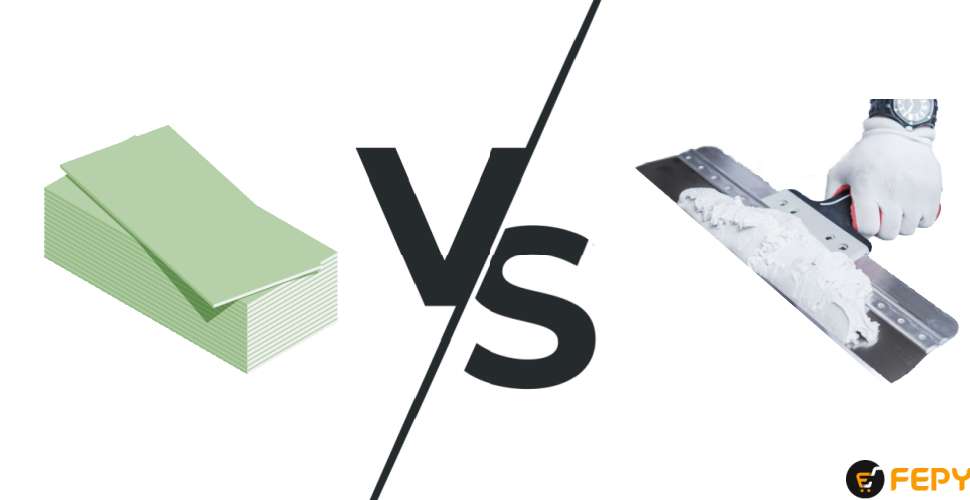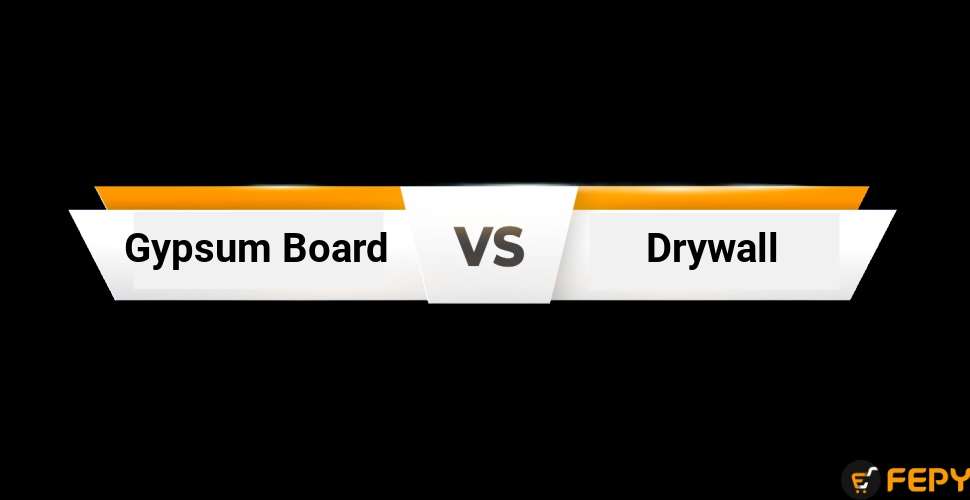Gypsum Board vs. Drywall: Understanding the Differences

April 15th 2024
Gypsum board and drywall are frequently used interchangeably in construction, yet these terms mask subtle but significant differences. Both are essential to modern building practices, but choosing the right one can affect your project's success. Let's explore the differences between drywall and gypsum board.
Gypsum Board vs. Drywall: 10 Key Differences

Now, let's dissect the ten core ways gypsum board and drywall diverge. Understanding their unique properties will help you choose the best material for your building project.
1. Material
Gypsum, a soft, naturally occurring mineral composed of hydrous calcium sulphate, lies at the heart of both materials.
Gypsum is a mineral found in large deposits worldwide. It is highly valued for its ability to resist flames and is widely used in various applications.
To create a gypsum board, manufacturers calcine raw gypsum. This heating process drives off water, leaving a fine white powder.
Mixing this powder with water and additives creates a paste that is applied to paper backing and dried.
Drywall, in contrast, is a manufactured product. Gypsum plaster (a mixture of gypsum, water, and additives) gets sandwiched between thick paper panels and kiln-dried for rigidity.
Though "drywall" is generic, "Sheetrock" is a popular brand name that people often associate with the entire product category.
Drywall's ease of installation, lightweight nature, fire resistance, and relative affordability make it a construction staple.
Key Takeaway: Although both use gypsum as a foundation, the production processes differ. Gypsum board originates from raw gypsum, while drywall uses gypsum plaster.
2. Water Content:
In its unprocessed form, gypsum boasts a surprising secret: hidden water molecules. Its chemical formula, CaSO4.2H2O, tells a tale of hydration woven into its crystalline structure. This bound water gives raw gypsum a degree of flexibility but also makes it vulnerable to the effects of high humidity.
Drywall, however, has another story. Gypsum plaster, its core component, lacks free water. The manufacturing process makes water an integral part of the plaster. This carefully controlled drying process gives drywall excellent moisture damage resistance, making it an intelligent choice for humid environments like kitchens or bathrooms.
Key Takeaway: Despite its greater resilience, drywall is not invincible. Prolonged water exposure can still compromise its integrity.
3. Crystalline Structure:
Gypsum's natural beauty lies in its crystalline foundation. This intricate structure grants it valuable traits like heat insulation and sound absorption. However, this same crystalline makeup can lead to shrinking and cracking as the gypsum dries and those trapped water molecules escape.
In contrast, drywall lacks a crystallised form. Its gypsum plaster core is a smooth paste and a critical factor in increased overall stability. This manufactured form helps minimise the shrinking and cracking often associated with its natural counterpart, gypsum board.
Key Takeaway: Water content and internal structure play pivotal roles in shaping the distinct characteristics of gypsum board and drywall.
4. Usage:
We understand gypsum as the natural foundation, a mineral awaiting transformation. This transformation is known as a gypsum board, a sandwich of gypsum plaster held between layers of paper or fibreglass. It gives us sturdy, versatile building access panels.
Drywall, however, is a more specialised product. It also starts with gypsum plaster, but this time, it is pressed between thick paper panels for a smooth, ready-to-finish surface. Think of drywall as a pre-built canvas designed for walls and ceilings.
Key Takeaway: Think of gypsum as the resourceful raw ingredient, while drywall is a specific, ready-to-use building material derived from it.
5. Types:
Gypsum's usefulness doesn't stop at the board! It's a star player in many construction materials:
- Plaster of Paris: This gypsum-based wonder acts as a rapid-setting binder.
- Cement: Gypsum even strengthens buildings through its role in cement production.
- Soil Conditioner: The mineral gypsum is beneficial to the soil itself, improving its fertility and structure.
Drywall, on the other hand, focuses on providing specialised wall and ceiling solutions:
- Regular Drywall (White Board): The most common choice for everyday building needs.
- Greenboard: Ideal for moisture-prone spaces like kitchens and bathrooms.
- Blueboard: Designed for veneer plastering and enhanced fire resistance.
- Purple Board: Brings superior water and mould resistance for tile-ready areas.
- Type X & C: These offer varying degrees of fire protection.
- Fiberglass or Paperless: A new contender, trading paper for fibreglass for even more excellent moisture resistance.
- Soundproof & Soundboard: Specifically engineered to reduce noise transmission.
- Enviroboard: Eco-conscious drywall made from recycled waste products.
Key Takeaways: Gypsum is a remarkably adaptable material, while drywall focuses on ready-to-use wall and ceiling solutions with specialisations.
6. Fire Resistance:
Gypsum, nature's fire-resistant mineral, acts as a shield thanks to its water content. Under the onslaught of flames, this trapped water transforms into steam, slowing the spread of fire while providing valuable time for evacuation.
Drywall, however, takes fire resistance to the next level. While also utilising gypsum plaster, it gains additional strength through additives and glass fibre reinforcement. These enhancements create a fire-resistant powerhouse, especially in the "Type X" form required by building codes in fire-prone regions.
Key Takeaway: Flame Spread Rating measures how fast fire spreads across a material's surface. Fire-resistant drywall boasts an impressive rating of 15 or even a remarkable 0 in some specialised products.
7. Manufacturing:
Creating the Gypsum board begins with a transformation: calcination. The intense heat of the process drives off the water from raw gypsum, leaving a powder ready to be mixed into slurries. This mixture then takes shape on a conveyor belt. A robust drying process finalises the strong board form.
Drywall, on the other hand, skips calcination. Its process centres on pressing gypsum plaster between sturdy paper panels. A kiln then removes excess moisture, yielding a rigid, ready-to-install sheet.
Key Takeaway: Both gypsum board and drywall rely on gypsum for their fire-resistant properties, but specialised manufacturing processes make drywall even more resilient in high-risk situations.
8. Cost
Goodbye, costly plaster! Gypsum board and drywall offer budget-friendly interior walls and ceilings.
Gypsum Board is the economic choice. The lower material costs and straightforward installation make it a smart choice for budget-minded builders.
Drywall's Efficiency Saves the Day. Drywall's manufacturing process and ease of installation translate directly into savings.
Key Takeaway: Fewer labour hours and lower material expenses make these two compelling alternatives to traditional plastering.
9. Installation
Gypsum board and drywall share a crucial advantage: ease of installation. It doesn't require specialised expertise, opening the door to potential DIY projects and saving on those labour costs.
Here's the basic process:
- Panels are cut to fit using a utility knife or specialised tools like a T-square.
- Screws or nails fasten the panels to the framing, spaced roughly every 12-16 inches.
- Tape and compound hide seams between panels, followed by sanding to ensure a flawless finish.
- Heavy drywall can make handling more difficult.
Safety First! Don't neglect these essentials:
- Eyes and Hands: Safety glasses and gloves protect against debris.
- Lungs: Dust masks are a must.
- Proper Support: Keep panels well-supported during installation to prevent accidents.
Key Takeaway: Though drywall panels can be a bit heavier, both options are easy to install, given the proper safety precautions and a little research on best practices.
10. Brands
While gypsum board and drywall describe the same material, the term you hear depends on who's speaking.
Architects and designers often favour gypsum board, while installers lean towards drywall.
What truly matters is choosing the right type of gypsum drywall for your project:
- Standard: The everyday workhorse for most rooms.
- Mould-Resistant: Ideal for humid areas to prevent unwelcome growth.
- Moisture-Resistant: Keeps its shape when humidity rises.
- Fire-Resistant: Offers varying levels of protection in fire-prone areas.
Key Takeaway: Knowing the distinctions between terms and drywall specialisations empowers you to make the wisest choices for your build.
Gypsum Board vs. Drywall: Comparison Table
| Parameter | Gypsum Board | Drywall |
| Material | Raw gypsum (a naturally occurring mineral) | Gypsum plaster (made from gypsum, water, and additives) |
| Water Content | Gypsum contains water in its crystalline structure | Drywall contains no free water within the gypsum plaster |
| Crystalline Structure | Gypsum has a crystalline structure | Drywall's gypsum plaster lacks a crystalline structure |
| Usage | Used as a base material in a variety of construction products | Primarily used as a finished wall and ceiling material |
| Types | Less variety in types compared to drywall | Wide range of types for specialized applications (e.g., fire-resistant, mold-resistant, etc.) |
| Fire Resistance | Naturally fire-resistant due to water content | Fire resistance can be further enhanced with additives and specialized types |
| Manufacturing | Includes calcination (heating to remove water) for processing | Made by pressing gypsum plaster between paper panels and kiln drying |
| Cost | Generally, a budget-friendly option | It can vary depending on the specific type of drywall |
| Installation | Relatively easy to install | Ease of installation can vary slightly based on drywall type |
| Brands | Various manufacturers | "Sheetrock" is a popular brand, but many others exist |
FAQs
Q. What is the lifespan of a gypsum board?
With proper installation and maintenance, the gypsum board enjoys a long lifespan. Under ideal conditions, a reliable wall and ceiling can easily last decades.
Q. Is gypsum board safe for health?
Gypsum itself is a naturally occurring mineral and is considered non-hazardous. However, always take precautions during installation, such as using a dust mask, as the cutting process can generate particles.
Q. Does the gypsum board need plastering?
Typically, no. The smooth paper facing on the gypsum board is designed for direct painting or wallpapering. However, plastering can be applied over it if a specific textured effect is desired.
Q. What is the cheapest wall-covering option?
Each project has unique factors, but the gypsum board often emerges as a highly cost-effective wall-covering solution. Its ease of installation and affordability make it a compelling choice when budgeting is a top concern.
Q. Which is better, gypsum or plaster?
Both gypsum board and traditional plaster offer advantages. Gypsum board excels in terms of installation speed and affordability. At the same time, plaster allows for greater flexibility in creating curved or unique shapes. The "better" choice depends on your project's specific needs and priorities.
Q. Is gypsum board cheaper than plywood?
In many cases, yes! Gypsum board often has a price advantage over plywood, especially when considering labour costs.
Final Words
Gypsum board or drywall, the name matters less than choosing the RIGHT type for your project. Understanding these variations is critical to creating structures that are safe, beautiful, and built to last.
For top-quality gypsum board, drywall, and all the tools you need, FEPY is the UAE's premier construction destination. Find unbeatable deals on the best brands, and remember to enable those notifications for even more savings opportunities!